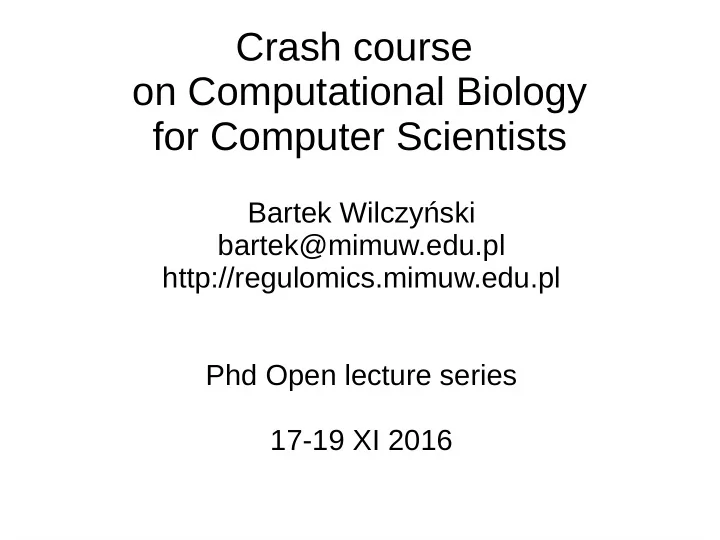

Crash course on Computational Biology for Computer Scientists Bartek Wilczyński bartek@mimuw.edu.pl http://regulomics.mimuw.edu.pl Phd Open lecture series 17-19 XI 2016
Topics for the course ● Sequences in Biology – what do we study? ● Sequence comparison and searching – how to quickly find relatives in large sequence banks ● Tree-of-life and its construction(s) ● Short sequence mapping – where did this word come from ● DNA sequencing and assembly – puzzles for experts ● Sequence segmentation – finding modules by flipping coins ● Data storage and compression – from DNA to bits and back again ● Structures in Biology – small and smaller
Markov Models
Hidden Markov Models ● Now the Markov Chain is not observable ● We only observe some emitted signals, probabilisticly depending on the chain state ● So in addition to the transition matrix, we have a emission matrix
Trajectories of HMMs ● The Markov model changes states (Xs) over time using transition matrix ● At each state a random symbol is emitted based on the emission probabilities
HMM example
Reconstructing trajectory states
Viterbi algorithm
The forward and backward probabilities of trajectories
Where were we at time t? Given the sequence of emitted symbols, we can estiimate the likely states of the hidden system
The emission matrix can be then estimated
As well as the transition matrix
Baum Welch algorithm
Expectation-Maximization
Protein structure
Protein domains
Profile HMMs
Finding a domain in a longer protein sequence
PFAM sequence annotation
What is the chromatin state? UCSF School of medicine
ChIP data from ENCODE project
Chromatin Immunoprecipitation data ● Considereble noise level
HMM model ● TileMap method (Ji&Wong 2005, Bioinfiormatics) ● Hidden Markov model for segmentation of ChIP data with 2 states: – 0 – no enrichment – 1 - enrichment ● Emissions are Gaussian
Emission model in TileMap
Using Gaussian HMM for Stock Market From scikit.learn documentation
You can use HMMs for chromatin Fillion et al, Cell 2010
Using PCA to limit the emission space dimension ● Principal component analysis is a method of identifying orthogonal vectors with maximal variance in the multidimensional data
Independent multidimensional emissions ● ChromHMM is taking a different approach ● One can assume that all of the different ChIP measurements are independent of each other ● Then instead of exponential emission explosion, we have a matrix of emission probabilities for each state ● For each observable ChIP we need the probabilities vector for each hidden state ● This is even extendable to Gaussian emissions
Ernst&Kellis, 2012, Nat Biotech
Emission matrix for Drosophila Modencode, Roy et al, Science 2010
Bayesian Networks and Dynamic Bayesian Networks
Segway Dynamic Bayesian Network Hoffman et al. Nat. Methods 2012
Protein structure prediction ● We can predict the protein sequence from reading DNA, but we do not know how it will fold to perform its function
Protein structure energy function ● Given our understanding of molecular dynamics, we should be able to score difgerent conformations of the same protein chain ● This is expensive, as proteins contain thousands of atoms
Simplifjed Computational models of protein structure
Anfjnsen's „conjecture” ● Since proteins can fold in the real world, the energy landscape should have a very strong global optimum
Computationally this is difficult ● Even the simplest model: – hydrophobic/polar representation of residues – On a rectangular lattive ● leads to a NP-hard problem of finding the optimal configuration
CASP experiment ● Critical Assessment of Structure Prediction methods ● Crystallographers solve structures and release sequences to scientists so that they can make blind predictions
Gamification of protein folding
Solving new HIV protein structure
Finding new algorithms
Making improved enzymes
Kryder's law ● For a long time the cost of magnetic storage was following Kryder's law of exponential reduction ● It is no longer the case ● It creates problems for storing all the sequencing data
Storing data in DNA ● Stored a text file, few images, a sound file in the DNA
Encoding of a binary stream in a sequencable DNA
Cost of storing data in DNA
Cost of retrieving DNA stored data
Cost comparison with tape storage
DNA is not only small it's also extremely durable
But they were not first to publish
This is all petty dispute about months...
Recommend
More recommend